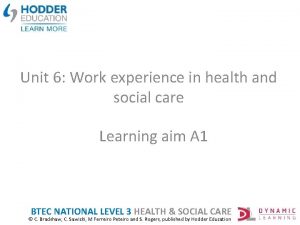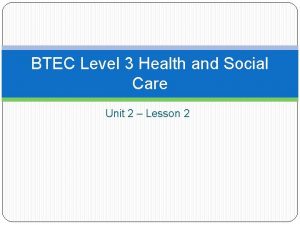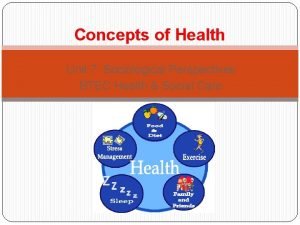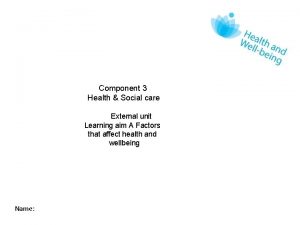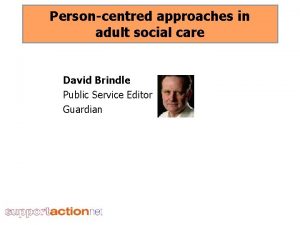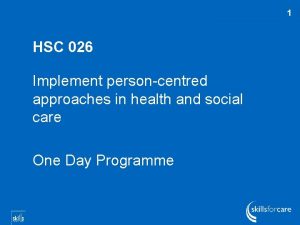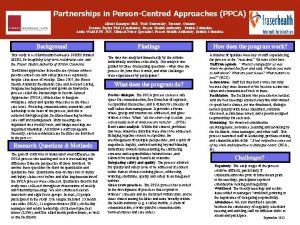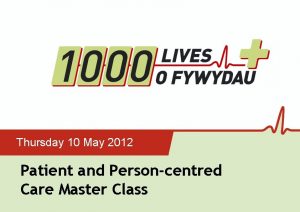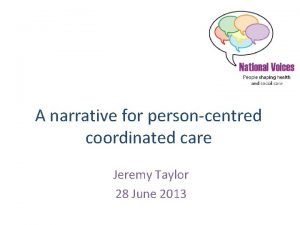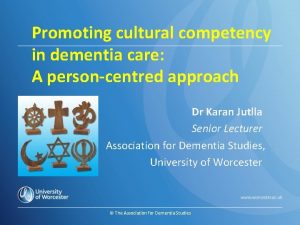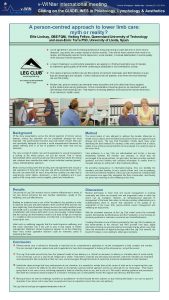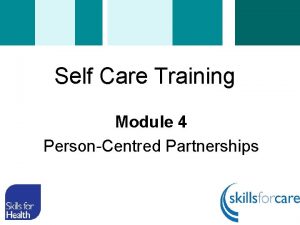Promote PersonCentred Approaches in Health and Social Care




























- Slides: 28

Promote Person-Centred Approaches in Health and Social Care • Skills for Care QCF Level 3 Certificate In Stroke Care • City and Guilds 3084

Group Agreement • • Time keeping Mobile phones Adult learning environment Confidentiality Respect WC? Fire alarms?

Outline of Training Day • Information Giving – Activities, Clips, discussion and feedback. • Activities in your work place.

What is Person-centred care? 1. 1 An approach to care planning and support which empowers individuals to make the decisions about what they want to happen in their lives. These decisions then form the basis for any plans that are developed and implemented.

Person Centred Values 1. 1 • Individuality • Independence • Rights • Respect • Choice • Dignity • Privacy • Partnership How do these values influence aspects of social work and why?

If you are being person centred, who are you working with? 1. 1 • The individual – someone requiring care or support. • Families, friends, advocates. Those of importance to the individual. • Others around the individual – Team members and colleagues, other professionals.

Care Plans / Support Plans 1. 2 Definition: (taken from Unit handbook) The document where day to day requirements and preferences for care and support are detailed.

Evaluating Care / Support Plans 1. 2 • What do care plans mean to you? • What should they include?

Assess • Needs • Difficulties • Strengths Evaluate • • Plan Formal Ongoing Implement • • • Day to day care • Goals for the future Practicalities Communication Management style/ organisation Induction/ training The Planning Cycle- Adapted from A little book of care planning. See refs. Walker, Manterfield 2010

Activity 1. 2 • • • Look at the support plans with your group. What do you like about it? What do you dislike? Does it need any more information? Have you had enough training to carry out the needs of the support plan? • Does it reflect person centred values?

Feedback…. . 1. 2

SCIE Clip

Working in a Person Centred way Activity 2. 1 • Split into groups- discuss and record the following – Discussion point 1 – How might you work in a Person Centred way on a day to day basis? Think about the values we have discussed. How can you bring those to life?

Maintaining Person Centred Approaches in complex or sensitive situations. 2. 2 Discussion point 2 • How can you demonstrate person centred values in a complex or sensitive situation?

Maintaining Person Centred Approached in complex or sensitive situations. 2. 2 For example – • Distressing or traumatic, eg Hospital Appointment, Individual out of regular environment. • Doing something the individual perceived to be threatening or frightening . • Likely to have serious implications or consequences, eg discussions about the future. • Of a personal nature – During personal care. • Involving complex communication or cognitive needs. (Making an activity meaningful with for someone with dementia. )

2. 3 • Will an individual’s needs and preferences always stay the same? • How can we adapt our actions and approaches?

Lucy’s Story… Cont LO 3 Watch the clip and think about capacity and consent.

• Jade’s slides here…. .

Case Study • Ann’s Story

Activity 4. 1 In groups: discuss and note. How could we make Ann an ‘Active Participant’ in her care?

Active Participation 4. 1 • Working in a way that recognises the person’s right to participate in activities and relationships of everyday life as independently as possible. • The person is regarded as an active partner in their own care / support rather than a passive recipient.

Activity cont… 6. 2, 6. 4 How can we ensure Ann’s wellbeing and spiritual needs are catered for?

Well being is connected to: • • 6. 2, 6. 4 Sense of Hope Self Esteem Confidence Identity Ability to communicate wants and needs Ability to make contact with other people Ability to show warmth and pleasure Experience of showing pleasure and enjoyment. ,

Activity Part 2: 4. 3 • How can active participation address holistic needs of an individual? • How will this consideration support Ann?

Think about… 4. 2 • Who would we involve to on agree how active participation will be implemented for Ann?

4. 4 How could you promote active participation in your own workplace?

Ann’s Story: Part 2 5. 1, 5. 2 • Discuss • How could you support Ann to make an informed choice about continuing to self medicate? • How could you use your role and authority to support Ann’s right to make her choices about her future dietary decisions?

Ann’s story- , Part 3 5. 3, 5. 4 • How would you support Ann to question or challenge the decision to not allow Ann to have a hot bath with candles? • How could you manage this risk whilst still enabling choice?
 Health and social care component 3
Health and social care component 3 Health and social care unit 2
Health and social care unit 2 Protect, promote, and improve the health of all people
Protect, promote, and improve the health of all people Models of appraisal in health and social care
Models of appraisal in health and social care Verna and sam case study answers
Verna and sam case study answers Primary, secondary, tertiary care
Primary, secondary, tertiary care Btec health and social care level 3 unit 6: work experience
Btec health and social care level 3 unit 6: work experience Unit 2 working in health and social care
Unit 2 working in health and social care Working in health and social care unit 2
Working in health and social care unit 2 Unit 14 health and social care example
Unit 14 health and social care example Pearson btec level 3 national extended diploma
Pearson btec level 3 national extended diploma Ocr cambridge technicals
Ocr cambridge technicals Ocr health and social care level 3
Ocr health and social care level 3 Advantages and disadvantages of robert vischer theory
Advantages and disadvantages of robert vischer theory Ocr health and social care
Ocr health and social care Greater manchester health and social care partnership
Greater manchester health and social care partnership Argyles theory of communication
Argyles theory of communication P3 unit 5 health and social care
P3 unit 5 health and social care Btec health and social care unit 2
Btec health and social care unit 2 What is intellectual in health and social care
What is intellectual in health and social care Unit 12 health and social care level 3
Unit 12 health and social care level 3 Unit 5 health and social care assignment
Unit 5 health and social care assignment Unit 27 health and social care
Unit 27 health and social care Health and social care unit 14 learning aim d
Health and social care unit 14 learning aim d Btec
Btec East ayrshire health and social care partnership
East ayrshire health and social care partnership Handling information in care settings
Handling information in care settings Unit 10 sociological perspectives
Unit 10 sociological perspectives Health and social care component 2 learning aim b example
Health and social care component 2 learning aim b example






